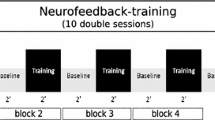This study investigates the neurophysiological basis of EEG feedback for patients with epilepsy. Brain areas are identified that become hemodynamically deactivated when epilepsy patients, trained in EEG self-regulation, generate positive slow cortical potentials (SCPs). Five patients were trained in producing positive SCPs, using a training protocol previously established to reduce seizure frequency in patients with drug refractory epilepsy. Patients attempted to produce positive SCP shifts in a functional magnetic resonance imaging (fMRI) scanner. Two patients were able to reliably produce positive SCP shifts. When these successful regulators were prompted to produce positive SCPs, blood oxygen level-dependent (BOLD) response indicated deactivation, in comparison to a control state, around the recording electrode, frontal lobe, and thalamus. Unsuccessful regulators’ BOLD response indicated no deactivation in cortical areas proximal to the active electrode. No thalamic deactivation was found in poor regulators. Decreased seizure frequency from SCP training may be the result of positively reinforced inhibition in cortical areas proximal to active electrode placement, the frontal cortex, and the thalamus.

Similar content being viewed by others
REFERENCES
Birbaumer, N. (1999). Slow cortical potentials: plasticity, operant control, and behavioral effects. The Neuroscientist, 5, 74–78.
Birbaumer, N., Elbert, T., Canavan, A., & Rockstroh, B. (1990). Slow cortical potentials of the brain. Physiological Reviews, 70, 1–41.
Braitenberg, V., & Schütz, A. (1991). Anatomy of the cortex: Statistics, geometry. Springer: Heidelberg.
Elbert, T., Rockstroh, B., Canavan, A., Birbaumer, N., Lutzenberger, W., von Bülow, I., et al. (1991). Self-regulation of slow cortical potentials and its role in epileptogenesis. In J. Carlson & R. Seifert (Eds.), International perspectives on self-regulation and health (pp. 65–95). New York: Plenum.
Hershey, T., Revilla, F. J., Wernle, A. R., McGee-Minnich, L., Antenor, J. V., Videen, T. O., et al. (2003). Cortical and subcortical blood flow effects of subthalamic nucleus stimulation in PD. Neurology, 61, 816–821.
Hinterberger, T., Veit, R., Strehl, U., Trevorrow, T., Erb, M., Kotchoubey, B., et al. (2003). Brain areas activated in fMRI during self-regulation of slow cortical potentials (SCPs). Experimental Brain Research, 152, 113–122.
Hinterberger, T., Veit, R., Wilhelm, B., Weiskopf, N., Vatine, J. J., & Birbaumer, N. (2005). Neuronal mechanisms underlying control of a brain–computer interface. European Journal of Neuroscience, 21(11), 3169–3181.
Ikeda, A., Terada, K., Mikuni, N., Burgess, R. R., Comair, Y., Taki, W., et al. (1996). Subdural recording of ictal DC shifts in neocortical seizures in humans. Epilepsia, 37, 662–674.
Kotchoubey, B., Kübler, A., Strehl, U., Flor, H., & Birbaumer, N. (2002). Can humans perceive their brain states? Consciousness and Cognition, 11(1), 98–113.
Kotchoubey, B., Schneider, D., Schleichert, H., Strehl, U., Uhlmann, C., Blankenhorn, V., et al. (1997). Stability of cortical self-regulation in epilepsy patients. NeuroReport, 8, 1867–1870.
Kotchoubey, B., Strehl, U., Uhlmann, C., Holzapfel, S., König, M., Fröscher, W., et al. (2001). Modification of slow cortical potentials in patients with refractory epilepsy: A controlled outcome study. Epilepsia, 42, 406–416.
Lauritzen, M. (2001). Relationship of spikes, synaptic activity, and local changes of cerebral blood flow. Journal of Cerebral Blood Flow and Metabolism, 21, 1367–1383.
Logothetis, N., Pauls, J., Augath, M., Trinath, T., & Oelterman, A. (2001). Neurophysiological investigation of the basis of the fMRI signal. Nature, 412, 150–157.
Monderer, R. S., Harrison, D. M., & Haut, S. R. (2002). Neurofeedback and Epilepsy. Epilepsy and Behavior, 3(3), 214–218.
Nagay, Y., Critchley, H. D., Featherstone, E., Fenwick, P. B., Trimble, M. R., & Rolan, R. J. (2004). Brain activity relating to the contingent negative variation: An fMRI investigation. Neuroimage, 21, 1232–1241.
Ogawa, S., Lee, T., Kay, A. R., & Tank, D. W. (1990). Brain magnetic resonance imaging with contrast dependent on blood oxygenation. Proceedings of the National Academy of Sciences of the United States of America, 87, 9868–9872.
Rockstroh, B., Elbert, T., Birbaumer, N., Wolf, P., Düchting-Röth, A., Reker, M., et al. (1993). Cortical self-regulation in patients with epilepsies. Epilepsy Research, 14, 63–72.
Sterman, M. B., & Friar, L. (1972). Suppression of seizures in an epileptic following sensorimotor EEG feedback training. Electroencephalography and Clinical Neurophysiology, 33(1), 89–95.
Strehl, U. (2003). Biofeedback of slow cortical potentials in epilepsy. In M. S. Schwartz & F. Andrasik (Eds.), Biofeedback: A practitioner's guide (3rd edn.). New York: Guilford Press.
Whitsett, S. F., Lubar, J. F., Holder, G. S., Pamplin, W. E., & Shabsin, H. S. (1982). A double-blind investigation of the relationship between seizure activity and the sleep EEG following EEG biofeedback training. Biofeedback and Self Regulation, 7(2), 193–209.
Worsley, K. J., Marrett, S., Neelin, P., Vandal, A. C., Friston, K. J., & Evans, A. C. (1996). A unified statistical approach for determining significant voxels in images of cerebral activation. Human Brain Mapping, 4, 58–73.
ACKNOWLEDGMENTS
This study was supported by the Deutsche Forschungsgemeinschaft (DFG) and the Bundesministerium für Bildung und Forschung (BMBF) and the National Institutes of Health (NIH). We thank Dr. Herta Flor for helpful comments on earlier versions of this paper.
Author information
Authors and Affiliations
Corresponding author
Rights and permissions
About this article
Cite this article
Strehl, U., Trevorrow, T., Veit, R. et al. Deactivation of Brain Areas During Self-Regulation of Slow Cortical Potentials in Seizure Patients. Appl Psychophysiol Biofeedback 31, 85–94 (2006). https://doi.org/10.1007/s10484-006-9006-6
Published:
Issue Date:
DOI: https://doi.org/10.1007/s10484-006-9006-6




